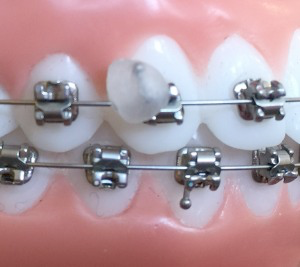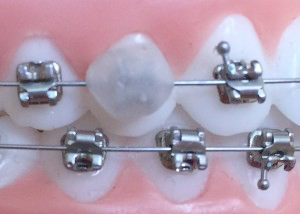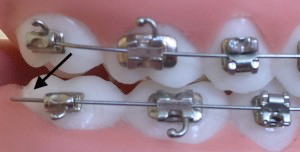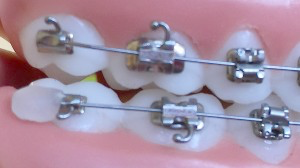Are there foods I should avoid when wearing braces?
When you’re wearing braces, the orthodontic appliances, brackets and wires can be damaged by some types of foods. That’s why your orthodontist gives you dietary guidelines. The foods you’ll want to keep away from your braces are primarily hard or sticky.
Just to be able to compare the do’s and don’ts, we’ll go over the “not to eat” foods first. Some of the things you’ll want to leave alone are:
- Nuts
- Popcorn
- Chewing gum
- Pizza crust
- Croutons
- Caramels
- Jelly beans
- Ice cubes
- Tootsie rolls
It’s easy to see how these things and other hard or sticky foods and candy would cause damage.
There are other foods you should be cautious about eating, and if you do feel you just have to have some of these things, cut or break them up and chew with your back teeth.
The “be cautious” list contains:
- Bagels
- Chicken wings
- Raw veggies
- Hard fruit like apples
- Fruit with pits
- Granola bars and
- Other items that might be hard, have bones, or might need to be cut up
- Also avoid foods high in sugar and brush soon after you do
Now here’s the good part! Let’s see how many of your favorites you can eat when wearing braces:
- Ice cream
- Potato chips
- Yogurt
- Pudding
- Cottage cheese
- Eggs
- Milkshakes
- Steamed vegetables
- Pasta
- Potatoes
- French fries
- Soft pretzels
- Sub sandwiches (cut up)
- Cheese
- Soup
- Crackers
- Cereal in milk
- Soft fruit
- String cheese
- Peas
- Cream corn
- Other things like hamburgers and so on can be cut up into small pieces
Things that are soft to chew and won’t stick to or inside your braces, and things that are not high in sugar are on your “go ahead and enjoy” list. Try to focus on eating with your back teeth and not the front, eat slowly, chew your food thoroughly, and remember – the list of things you can eat is a whole lot longer and healthier than the list of things you can’t eat!
What is considered an orthodontic emergency?
True orthodontic emergencies are very rare during orthodontic treatment. Some inconveniences should be expected during treatment and are considered normal. Many times repairs can be handled during your next scheduled appointment, however, we are here to serve you and encourage you to contact our office if you have any questions. For orthodontic emergencies that can wait for regular office hours please reference the list below for solutions to commonly encountered orthodontic issues.


3. Poking Wire: Try the following if a wire is causing you discomfort:
- Clip the end of the wire with nail clippers (make sure to secure the wire before clipping)
- Place wax on the end of the wire
- If the wire is out of the tube in the back you can place the wire back in with tweezers.
If you are still having issues, you can call the office during regular patient hours to schedule an appointment to have the poking wire fixed.
4. Spacer(s) Fell Out: Spacers are the rubber bands that we put BETWEEN your teeth (not around the braces). If you have lost any of your spacers then you will need to make an appointment to have the spacers replaced before your next appointment. If you do not come in to get the spacers placed again, the doctor will not be able to perform the procedure that is planned for your next appointment.
5. Broken Retainer: You should schedule an appointment as soon as possible to have the broken retainer repaired/replaced.
Myths & Facts about braces
MYTH: Orthodontists are appropriate only for the most challenging and complex orthodontic cases.
FACT: Orthodontists have the education, experience and expertise to recognize the difference between a simple case and a complex one. And when a case is challenging, orthodontists know what to do.
MYTH: My family dentist says he can straighten my teeth.
FACT: Orthodontists receive more formal education than dentists to specialize in straightening teeth. Like dentists, orthodontists graduate from dental school. Then, to be an orthodontist, it takes an additional two to three academic years of education in an accredited orthodontic residency program. Orthodontists are dentistry’s specialists in straightening teeth and aligning jaws to create optimal function and form. Orthodontists only practice orthodontics. They treat hundreds of patients a year, drawing on tried-and-true and new orthodontic appliance technologies to get patients to the best results. Orthodontists have knowledge of the full range of orthodontic appliance “tools”—including braces, clear aligners and other orthodontic devices. They know what to use and when because they work with these tools every day. Orthodontists build on their knowledge of orthodontics through on-going continuing education in orthodontic technology and practice.
MYTH: Braces are for kids.
FACT: One in five orthodontic patients is an adult.
MYTH: If there was a giant, overhead magnet and someone flipped a switch, people wearing braces would fly out of their chairs and stick to the ceiling.
FACT: Unlikely, as braces are made from non-magnetic materials.
MYTH: Braces are painful and take two years or more for the desired result.
FACT: After the adjustment period, like breaking in a new pair of shoes, braces are comfortable. Some may be worn for months, not years.
MYTH: Signals from braces link to the Internet to download songs onto an iPod.
FACT: This is not possible right now.
MYTH: Braces are ugly, call attention to themselves and would be embarrassing in business settings.
FACT: Today’s braces may be nearly invisible, made from clear plastic, or unseen, mounted on the back (lingual) side of the teeth.
MYTH: Orthodontists have a low profile
FACT: Orthodontists give back to the community by offering free, discounted, services to patients in need.
MYTH: Any dentist may join the American Association of Orthodontists
FACT: Only orthodontists may become members of the American Association of Orthodontists.
© American Association of Orthodontists and Braces.org, 01/17/2012
Why do people seek orthodontic treatment?
The 3 main reasons why people seek orthodontic treatment are:
- To improve facial and smile appearance
- To improve oral health
- To improve oral function
The positive changes produced by orthodontic treatment can have a significant effect on a person’s quality of life and self-esteem. Research suggests that an attractive smile carries social benefits at all ages and levels of society, while an unattractive smile can be a significant social handicap.
Orthodontic treatment can improve oral health in several ways. Straight teeth are much easier to keep clean than crowded teeth. Crowded teeth are more difficult to properly brush and floss, which may contribute to tooth decay and/or gum disease. Certain types of problems with the bite can contribute to damage of the teeth and/or gums (i.e. people with a severe overbite are at a higher risk of fracturing the upper front teeth). Other types of poor bites can contribute to uneven wearing of certain teeth and severe loss of gum tissue, which can result in premature tooth loss. Certain bite issues can result in difficulty chewing, speaking properly and may exacerbate damage to teeth in people with clenching and grinding patterns.
Our society’s appreciation of these facts (and many others) has led to the increased numbers of children and adults that are seeking orthodontic treatment.
Why are orthodontists referred to as smile specialists?
You can’t get a healthy, beautiful smile from just anyone. You need an expert. You need an orthodontist.
Orthodontists are highly trained specialists whose expertise is tooth alignment for children, teens and adults. But what exactly makes them the experts? Only orthodontists receive an extra 2-3 years of specialized education beyond dental school to learn the proper way to align and straighten teeth.
That means to become an orthodontist, qualified dentists need even more training after graduating dental school. In fact, they need an additional full-time education at an accredited orthodontic residency program supervised by orthodontists. This education lasts at least two years, often more.
During this time, orthodontists learn about tooth movement (orthodontics) and the guidance of facial development (dentofacial orthopedics). It’s this education and training in straightening teeth and aligning jaws that make orthodontists the straight-smile experts.
By selecting a member of the American Association of Orthodontists (AAO), you can feel confident knowing you’ve chosen an orthodontic specialist that is an expert in orthodontics, dentofacial orthopedics and the treatment of improperly aligned teeth and jaws. It’s why only orthodontists can become members of the AAO. It’s also why our expertise will make you smile.
© American Association of Orthodontists and Braces.org, 01/17/2012
When should I go see an orthodontist?
Recognize any of these early warning signs? It might be time to schedule an orthodontic exam.
- Early or late loss of baby teeth
- Difficulty chewing or biting
- Mouth breathing
- Finger sucking or other oral habits
- Crowding, misplaced or blocked-out teeth
- Jaws that shift, make sounds, protrude or are recessed
- Speech difficulty
- Biting the cheek or biting into the roof of the mouth
- Protruding teeth
- Teeth that meet in an abnormal way or don’t meet at all
- Facial imbalance or asymmetry
- Grinding or clinching of teeth
© American Association of Orthodontists and Braces.org, 01/17/2012
Why would someone want their teeth straightened?
While you may only be thinking about the attractiveness of a beautiful smile, there are actually many other benefits to straight teeth. In fact, there are enough to make you think that a gorgeous smile is nothing more than a pleasant side effect of orthodontic treatment.
With straight teeth, you can bite, chew and speak more effectively. Properly aligned teeth and jaws not only contribute to healthier teeth and gums, they may even alleviate or prevent physical health problems. And let’s face it; teeth that work better tend to look better. An attractive smile is a wonderful asset to display. It contributes to your self-confidence and your self-image, which are important qualities at any age.
With the health benefits, a pleasing appearance and more self-confidence, orthodontic treatment gives people a lot to be happy about. Let our expertise make you smile.
© American Association of Orthodontists and Braces.org, 01/17/2012
Do braces hurt when you put them on?
Patients typically do not experience discomfort during placement of braces. Patients may not love the retractors (things placed in mouth to keep cheeks away from the teeth) that we need to use to keep your teeth dry but the actually placement does not hurt. Generally, patients will experience discomfort later that day or the following day after placement. This discomfort is usually only felt during eating and usually does not last longer than 7-10 days after placement.
What can I eat with braces?
You need to avoid hard and sticky foods when you have braces on. Some items to be avoided include: nuts, popcorn, chewing gum, croutons, caramels, starburst, jelly beans, ice cubes, and tootsie rolls. For more information on this topic see our eating with braces tab.
Can I see my general dentist while I have braces on?
Yes, you can and it is very important that you see your dentist for regular cleanings and checkups while you have braces on.
My dentist that does my cleanings also does braces; what is the difference between my regular dentist and an orthodontist?
Both a General Dentist and Orthodontist have to graduate from dental school. In dental school they both learn things like cleaning teeth, extracting teeth, removing cavities and placing fillings. Once a dentist graduates from dental school they go on to practicing general dentistry. An Orthodontist continues with education and completes at least two years of both clinical and academic study. During this time an orthodontist treats patients under the supervision of other orthodontist. They have the opportunity to see treatment cases from start to finish and are exposed to a variety of dental problems. Orthodontists limit the majority of their practice to Orthodontics. Thus, they have an opportunity to treat more cases and often see more complex cases as well. Think of this like your family doctor and your OBGYN. Most people would not let their family doctor deliver their baby even though their family doctor may know how to.
Do I have to wait for all my permanent teeth to come out before coming to see the orthodontist?
Some people believe or are even told they have to wait until they lose all their baby teeth before coming to the orthodontist. The American Association of Orthodontics actually recommends that all children should be seen by age 7. For some patients it is better to begin treatment with some baby teeth as the baby molars are larger than the teeth that replace them and this extra space can be used to relieve crowding.
How much do braces cost?
The prices of braces can range largely. Braces generally range from $3000-$5000. The price can vary depending on difficulty of case, appliances needed for treatment, and type of braces. At our office we have a number of payments plans and most patients have monthly payments between $100-$150 a month.






